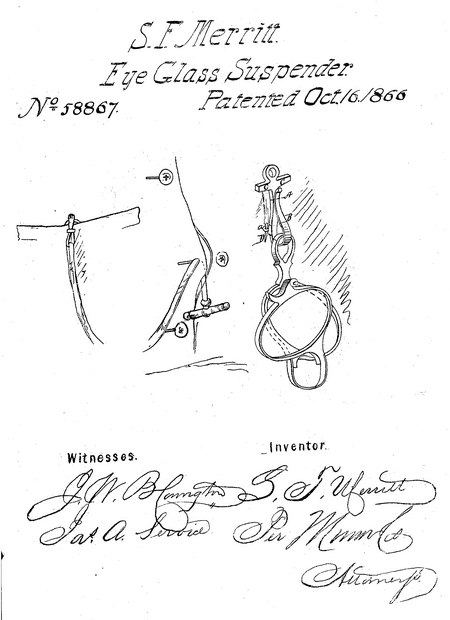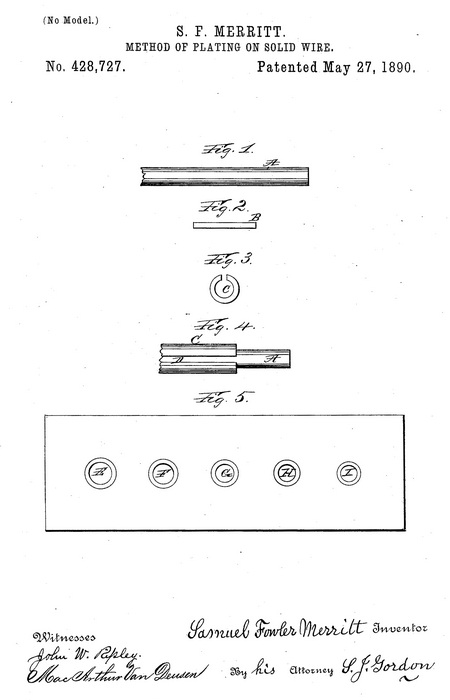Samuel Fowler Merritt
- Born: 10 Dec 1820, Rye NY
- Marriage (1): Mary Ann Landen on 18 Apr 1843 in New York City NY
- Died: 27 Aug 1895, Springfield MA
General notes:
Jeweler
Events in his life were:
- He worked in 1841-1849 as a jeweler in New York City NY in the shop of his old master.
- Partnership: Joseph B. Bowden, in 1849-1850, in New York City NY. As BOWDEN & MERRITT, manufacturing jewellers at 5 Dey Street.
- He appeared on the census in 1850 in New York City NY. Listed as a jeweler.
- He worked in 1850-1865 as a jeweler in Springfield MA again working for his former master, James Rumrill.
- He appeared on the census in 1860 in Springfield MA. Listed as a jeweler.
- He worked in 1865-1867 as a spectacle maker in New York City NY as the superintendent of the Burbank Spectacle Company.

- Patent: 58,867, on 16 Oct 1866. S. F. MERRITT, OF NEW YORK, N. Y. IMPROVEMENT IN EYEGLASS-SUSPENDERS.
Specification forming part of Letters Patent No. 58,867, dated October 16, 1866.
To all whom it may concern :
Be it known that I, S. F. Merritt, of the city, county, and State of New York, have invented a new and improved Device for Holding-Eyeglasses, &c, on the Clothes of the Wearer; and I do hereby declare that the following- is a full, clear, and exact description thereof, which will enable others skilled in the art to make and use the same, reference being- had to the accompanying drawing, forming part of this specification.
My invention consists in a device to be hooked into the vest or other wearing-apparel of a person for holding a pair of eyeglasses, the same being composed, in detail, of a snap-hook having a cross-piece at the top of its shank for keeping it in a proper position, and a pin secured to its back for fastening it to the clothes of a person.
The drawing is a perspective view of my invention, showing it as holding or supporting a pair of eyeglasses.
A B designate the part of the device which I term the "snap-hook," A being the shank, and B the hook, the end of tie latter being so bent as to spring against the former, and thus prevent any casual dropping off from the hook of any article hung thereon. C is a bar at or near the top of the shank, extending out from either side thereof. This bar C not only renders the device more ornamental, by giving it somewhat the appearance of an anchor, but it serves to prevent the hook turning sidewise, and therefore the hook is always kept in a proper position for placing upon the same the ring or eye attached to the bows of the eye-glass, as well as to permit the ready withdrawal of the same.
Secured to the back of the shank A there is a pin, D, which is hinged or pivoted in a similar way to the pins attached to ordinary breastpins, and to the lower end of the shank there "is a catch, a, into which to place the end of the pin for confining it, as in an ordinary breastpin.
The device may be made, in whole or in part, of the same or different metals or materials, and as ornamental as desired.
The device is shown as secured in the side of a gentleman's vest in a position very accessible to the hand, and where it would not be likely to come in contact with anything so as to be injured; but it may be attached in any proper position on the person's clothing.
The device is ornamental and useful, and by its use the neck-cord usually employed for holding a pair of eyeglasses may be dispensed with, and hence the wearer will be relieved of an appendage always in the way.
Having thus described my invention, T claim as new and desire to secure by Letters Patentó
As a new article of manufacture, an eyeglass-holder consisting of the shank A, spring-hook B, bars C, eye a, and pin D, substantially as described, for the purpose specified.
The above specification of my invention signed by me this 13th day of June, 1866.
S. F. Merritt
Witnesses:
Wm F. McNamara
M. M. Livingston
- He worked in 1868-1890 as a jeweler in Springfield MA
- He appeared on the census in 1880 in Springfield MA. Listed as a jeweler.

- Patent: 428,727, on 27 May 1890. SAMUEL FOWLER MERRITT, OF SPRINGFIELD, MASSACHUSETTS.
METHOD OF PLATING ON SOLID WIRE.
Specification forming part of Letters Patent No. 428,727, dated May 27, 1890.
Application filed January 7, 1890, Serial No. 336,192, (No model)
To all whom it may concern:
Be it known that I, Samuel Fowler Merritt, of Springfield, county of Hampden, State of Massachusetts, have invented a new and useful Improved Method of Plating on Solid Wire, which is fully set forth in the following-specification.
The purpose of my invention is to so cover a composition rod with a plating of gold that it will be solid and seamless when completed without waste of gold.
Heretofore the method followed in jewelry manufacture was to cover a block of composition with a layer of gold soldered or sweated thereon. The block was rolled to the desired thickness, curved into a tube, and the joint soldered or not, as was preferred. The tube was drawn down into the wire, a hole being necessarily left in the center, no matter how finely the wire was drawn, which hole prevented making a solid point at the end of a piece cut therefrom. In making the point the end was hammered flat and a piece clipped off lengthwise, the piece going into the scrap subject to waste in remelting.
In the drawings, Figure 1 is a side view of the solid composition rod; Fig. 2, an end view of the prepared sheet; Fig. 3, an end view of the tube ready for the reception of the solid composition rod; Fig. 4,. a top view of the solid composition rod inserted within the tube; Fig. 5, a front view of the draw-plate.
In these figures, letter A represents a solid composition rod; B, a thin sheet of gold; C, the tube formed thereof; D, the joint between its edges; E, F, G, H, and I, holes of different diameters in the draw-plate.
My improved method is to cut prepared sheet B into widths proportionate to the size of solid composition rod A to be covered. Sheet B is then curved about composition rod A, leaving an open space or joint D between the edges of sheet B. After pickling and cleaning rod A and sheet B, rod A is reinserted within tube C and a piece of silver solder laid in the open space or joint D between the edges of tube C. Flowing the solder fills the space between rod A and tube C, leaving joint D open. Drawing this gold-covered rod through a draw-plate, presenting successively diminishing holes of compression E, F, G, H, and I, gradually closes the space or joint D between the edges of tube C until it is unrecognizable, obliterating the joint and leaving the edges apparently consolidated. This rod may then be drawn down through smaller and smaller holes to any desired fineness, and a pin-point made at any point of severance will be solid, as rod and plate are homogeneous. The rod is left long-enough to make a point for drawing, so that no gold is lost by clipping or filing.
What I claim, and desire to secure by Letters Patent, isó
The process within described of plating a rod by flowing solder about the same between the tube and rod, closing the joint, and attenuating the consolidated tube and rod, in the manner and by the means set forth.
Samuel Fowler Merritt
Witnesses:
J. G. Dunning
J. E. Landen
Samuel married Mary Ann Landen on 18 Apr 1843 in New York City NY. (Mary Ann Landen was born in 1821 in Egerton Kent England and died on 29 Dec 1901 in Springfield MA.)
|



